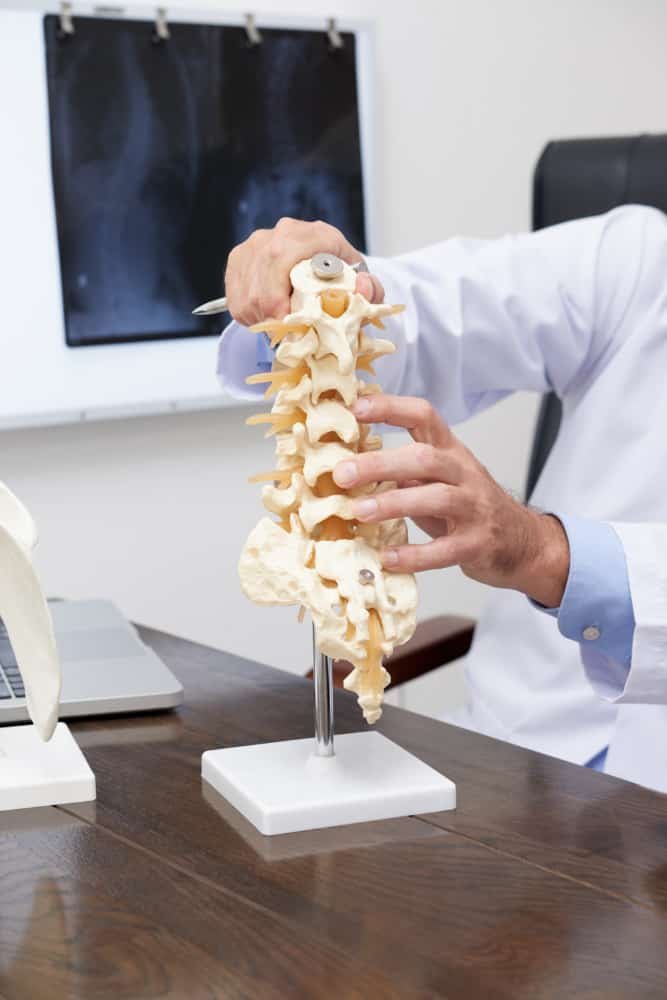Not all spinal problems need surgery, some problems, particularly those associated with spinal cord or nerve injury, commonly require fusion as part of the surgical treatment.
The objective of lumbar (lower back) fusion surgery is to stop or prevent abnormal motion in between the vertebrae thus, relieve pain, numbness, tingling sensations, and weakness and restoring nerve function. There are several potential reasons to consider spinal fusion surgery to stabilize a weak or unstable spine (caused by infections or tumors), fractures, scoliosis, or deformity. This is done by fusing (joining) the two or more adjacent vertebrae together. In most cases, spinal fusion can eliminate pain and other symptoms. It is important for a spine surgeon to explain the options, and benefits of spinal fusion surgery.
Usually, spinal fusion surgery includes different procedures, such as decompression or foraminotomy—both procedures are performed to ease the pressure off a spinal nerve. Bones can be fused together using
1. By the normal inflammatory response of our body
2. By putting a bony fragment from some other part of our body (autograft)
3. By putting some bone fragments stored in the bone bank (allograft)
4. By putting cages in between
After removing the disc, the raw vascular surface of the bone is filled with the bone and fixed using a screw and rod or plates to immobilize the area. After about 4-6 weeks the graft bed heals and fuses forming a single segment.
For patients with the following conditions, if abnormal and excessive motion at a vertebral segment results in severe pain and inability to function, then a fusion procedure may be considered:
• Spondylolisthesis (isthmic, degenerative, or post-laminectomy spondylolisthesis)
When low back fusion surgery is necessary?
If a patient’s low back pain and other symptoms do not improve with nonsurgical treatments like medications, physical therapy, and/or spinal injections. Spine surgery may be recommended or considered if symptoms worsen, or the patient develops neurologic symptoms. Usually, neurologic symptoms include nerve pain, numbness, tingling sensations, sciatica, and leg weakness.
What types of spine problems are treated with lumbar spinal fusion?
• Spondylolisthesis Problem: It occurs when a condition in which one bone of the spine slips over another, out of its proper place. Spondylolisthesis symptoms include back pain and leg pain or weakness when standing for long periods. Fusion surgery usually helps correct that abnormal movement.
• Degenerative Disc Problem: The disease develops over time and causes one or more intervertebral discs to shrink, which changes the structure and strength of the disc. structurally, as disc height is reduced, spinal nerves can become compressed causing sciatic-like symptoms. A fusion procedure can restore the proper spacing and relieve the pressure on the nerve.
How Spinal Fusion Works?
At each level in the spine, there is a disc space in the front and paired facet joints in the back. Working together, these structures define a motion segment and permit multiple degrees of motion. A spinal fusion is the permanent joining of two or more vertebrae so that there is no movement between them. Over time they heal into a single, solid bone.
A bone graft can be taken from the patient’s hip (autograft bone) during the spine fusion surgery, harvested from cadaver bone (allograft bone), or manufactured (synthetic bone graft substitute).
What are the risk complications of lumbar spine fusion surgery?
Like any surgical procedure, risks are also associated with spine fusion surgery. Your spine surgeon will be responsible to reduce the risk associated with the procedure.
However, there are certain patients who are at high risk for pseudoarthrosis—the term for a fusion that does not heal easily; also referred to as a non-union. Patients who smoke, are exposed to excessive alcohol, have diabetes, or take specific drugs like(Steroids, etc..) are more risk-prone for a failed surgery. Your spine surgeon will assess your condition and discuss your potential risk factors. Depending on the health condition he may prescribe a bone growth stimulator to be used after surgery to help your spine heal.
Can spinal fusion procedures be done using minimally invasive?
Yes, with the help of the tubular retractor system along with sextant, these procedures can be done in a minimally invasive manner.
Spinal fusion surgery recovery:
A patient needs to spend 3-4 days in the hospital, however, in serious cases; the hospitalization could in fact stretch out to 5-6 days. For older individuals, it is suggested that after the spinal surgery procedure, they ought to remain in for about seven days, so that the proper patient care can be taken.
Dr. Vishal Bhasme is a United States trained spine surgeon from Pune, India. He strives to offer best and consistent patient care services in the field of Spine Surgery.
Image Credits:















